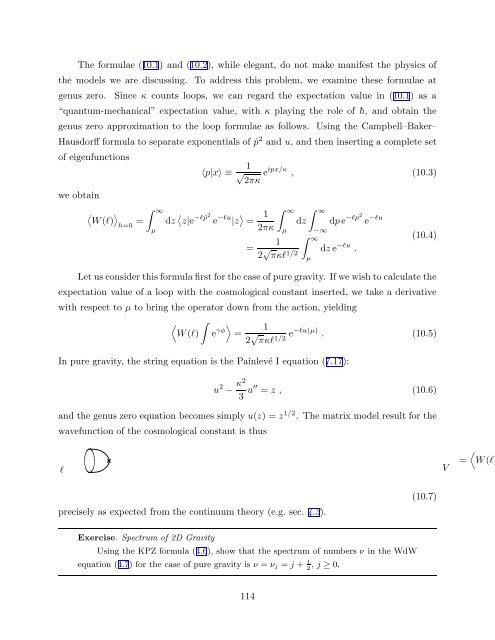arXiv:hep-th/9304011 v1 Apr 5 1993
arXiv:hep-th/9304011 v1 Apr 5 1993
arXiv:hep-th/9304011 v1 Apr 5 1993
You also want an ePaper? Increase the reach of your titles
YUMPU automatically turns print PDFs into web optimized ePapers that Google loves.
The formulae (10.1) and (10.2), while elegant, do not make manifest <strong>th</strong>e physics of<br />
<strong>th</strong>e models we are discussing. To address <strong>th</strong>is problem, we examine <strong>th</strong>ese formulae at<br />
genus zero.<br />
Since κ counts loops, we can regard <strong>th</strong>e expectation value in (10.1) as a<br />
“quantum-mechanical” expectation value, wi<strong>th</strong> κ playing <strong>th</strong>e role of ¯h, and obtain <strong>th</strong>e<br />
genus zero approximation to <strong>th</strong>e loop formulae as follows. Using <strong>th</strong>e Campbell–Baker–<br />
Hausdorff formula to separate exponentials of ˆp 2 and u, and <strong>th</strong>en inserting a complete set<br />
of eigenfunctions<br />
we obtain<br />
〈p|x〉 ≡ 1 √<br />
2πκ<br />
e ipx/κ , (10.3)<br />
〈<br />
W (l)<br />
〉h=0 = ∫ ∞<br />
µ<br />
dz 〈 z|e −lˆp2 e −lu |z 〉 = 1<br />
2πκ<br />
=<br />
∫ ∞<br />
µ<br />
∫<br />
1 ∞<br />
2 √ πκl 1/2<br />
∫ ∞<br />
dz dp e −lp2 e −lu<br />
−∞<br />
µ<br />
dz e −lu .<br />
(10.4)<br />
Let us consider <strong>th</strong>is formula first for <strong>th</strong>e case of pure gravity. If we wish to calculate <strong>th</strong>e<br />
expectation value of a loop wi<strong>th</strong> <strong>th</strong>e cosmological constant inserted, we take a derivative<br />
wi<strong>th</strong> respect to µ to bring <strong>th</strong>e operator down from <strong>th</strong>e action, yielding<br />
〈 ∫ 〉<br />
W (l) e γφ 1<br />
=<br />
2 √ πκl 1/2 e−lu(µ) . (10.5)<br />
In pure gravity, <strong>th</strong>e string equation is <strong>th</strong>e Painlevé I equation (7.17):<br />
u 2 − κ2<br />
3 u′′ = z , (10.6)<br />
and <strong>th</strong>e genus zero equation becomes simply u(z) = z 1/2 . The matrix model result for <strong>th</strong>e<br />
wavefunction of <strong>th</strong>e cosmological constant is <strong>th</strong>us<br />
l<br />
V<br />
=<br />
〈<br />
W (l)<br />
precisely as expected from <strong>th</strong>e continuum <strong>th</strong>eory (e.g. sec. 4.3).<br />
(10.7)<br />
Exercise. Spectrum of 2D Gravity<br />
Using <strong>th</strong>e KPZ formula (4.6), show <strong>th</strong>at <strong>th</strong>e spectrum of numbers ν in <strong>th</strong>e WdW<br />
equation (4.7) for <strong>th</strong>e case of pure gravity is ν = ν j = j + 1 2 , j ≥ 0.<br />
114
















